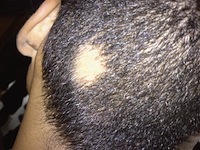 Alopecia areata is usually regarded as an autoimmune disease, which strikes men and women, typically under the age of 30. It often starts with loss of hair in small coin size patches which can then multiply, join together and at least in a quarter of cases lead to complete baldness.
Alopecia areata is usually regarded as an autoimmune disease, which strikes men and women, typically under the age of 30. It often starts with loss of hair in small coin size patches which can then multiply, join together and at least in a quarter of cases lead to complete baldness.
There is no known cure for the condition and generally the outlook is bleak for most sufferers, who can expect little chance of hair regrowth in affected areas, along with an increased chance of further outbreaks.
There is, however, the possibility of some light at the end of the tunnel as genetic studies may at last be at a point where they can help target the cause of the disease.
What are the causes?
The condition occurs when healthy hair follicles develop autoantigens which are mistaken as danger signals, like infections or cancer by the immune system, which then attacks the healthy follicles. To date the best treatment a patient can hope for is a temporary suppression of the immune system with cortisone or allergic contact dermatitis, which changes the immune response to a less damaging one.
The reality is that neither of these treatments are particularly successful because they don’t target the root cause of the problem: the process which makes the hair follicles develop autoantigens in the first place. This may be about to change though with some important breakthroughs in the last few years.
Genetically closer to diabetes than psoriasis
In 2014, Angela Christiano, a geneticist from Columbia University, New York published a paper that showed a drug, previously used for bone marrow disorder, restored the hair growth in three patients with chronic and severe alopecia areata.This followed decades of genome wide association study to try to understand the genetics of the condition in order to identify ways to target it.
This work indicated that the condition wasn’t a relative of psoriasis, as had been previously thought, but was, in fact more closely related to diabetes, coeliac and rheumatoid arthritis. It also identified a gene that is unique to alopecia: ULBP.
Treatments
This new understanding of the disease has led to some promising clinical trials by Christiano and others, where the use of inhibitors normally used for rheumatoid arthritis have shown some success in arresting the progress of the disease and in some cases actually preventing relapses.
These results, although exciting and a huge step forward should be viewed with some caution though. The test groups have been small and the disease often retreats itself, making it difficult to attribute the success to the treatment. In addition to this some patients do not respond to these treatments at all, suggesting that there may be subgroups of the disease at work.
The groundwork has clearly been done by Christiano and her colleagues to identify a cure for a previously untreatable disease, although there is still some way to go. The onus is now on the large biopharmaceutical companies to develop promising new treatments and bring them to market if a general answer is to be found for all alopecia areata sufferers.
